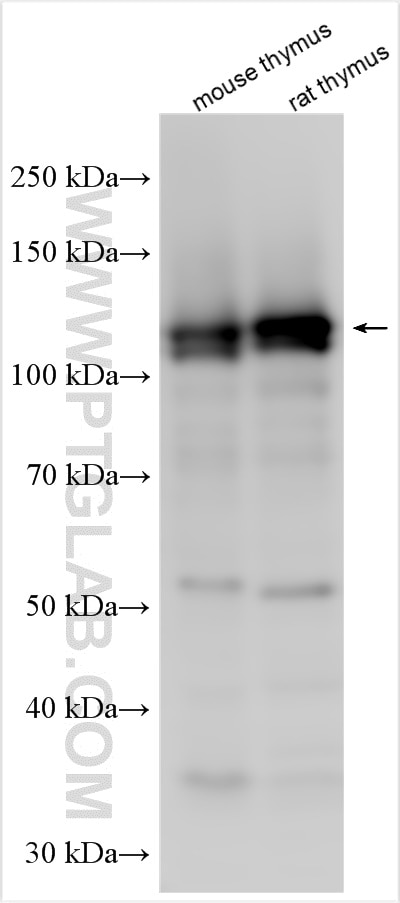Tested Applications
| Positive WB detected in | mouse thymus tissue, rat thymus tissue |
Recommended dilution
| Application | Dilution |
|---|---|
| Western Blot (WB) | WB : 1:500-1:2000 |
| It is recommended that this reagent should be titrated in each testing system to obtain optimal results. | |
| Sample-dependent, Check data in validation data gallery. | |
Product Information
20977-1-AP targets RAG1 in WB, ELISA applications and shows reactivity with human, mouse, rat samples.
| Tested Reactivity | human, mouse, rat |
| Host / Isotype | Rabbit / IgG |
| Class | Polyclonal |
| Type | Antibody |
| Immunogen | Peptide Predict reactive species |
| Full Name | recombination activating gene 1 |
| Calculated Molecular Weight | 119 kDa |
| Observed Molecular Weight | 110-120 kDa |
| GenBank Accession Number | NM_000448 |
| Gene Symbol | RAG1 |
| Gene ID (NCBI) | 5896 |
| RRID | AB_3669352 |
| Conjugate | Unconjugated |
| Form | Liquid |
| Purification Method | Antigen affinity purification |
| UNIPROT ID | P15918 |
| Storage Buffer | PBS with 0.02% sodium azide and 50% glycerol , pH 7.3 |
| Storage Conditions | Store at -20°C. Stable for one year after shipment. Aliquoting is unnecessary for -20oC storage. 20ul sizes contain 0.1% BSA. |
Background Information
Recombination-activating gene (RAG) proteins include RAG1 and RAG2, which are crucial for Ig and T lymphocyte receptor (TCR) fragment rearrangement and are responsible for DNA recognition and cleavage at specific sequences. Mutations in RAG1 result in the complete or partial loss of recombinant enzyme activity, in unbalanced variable-diversity-joining (V(D)J) recombination, and in the impairment of T and B lymphocyte development at the early stages.
Protocols
| Product Specific Protocols | |
|---|---|
| WB protocol for RAG1 antibody 20977-1-AP | Download protocol |
| Standard Protocols | |
|---|---|
| Click here to view our Standard Protocols |



